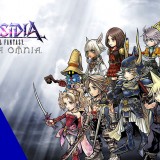
GAME REVIEW: Dissidia Finaly Fantasy Opera Omnia – My Other Game Is A Rolls-Royce, But This One Is, Too
Raves
Rants
Square Enix began their conquest of 2018 in January, with the worldwide multi-platform release of its highly-anticipated Dissidia Final Fantasy NT, follow-up to their immensely popular Dissidia Final Fantasy and Duodecim Dissidia Final Fantasy titles for the PlayStation Portable. And while critics and fans alike were, once again, in heated discussion over why every little detail of […]
Square Enix began their conquest of 2018 in January, with the worldwide multi-platform release of its highly-anticipated Dissidia Final Fantasy NT, follow-up to their immensely popular Dissidia Final Fantasy and Duodecim Dissidia Final Fantasy titles for the PlayStation Portable. And while critics and fans alike were, once again, in heated discussion over why every little detail of the game works or doesn’t work, Square Enix quietly announced and rather hastily released its little mobile cousin, Dissidia Final Fantasy Opera Omnia for Android and iOS at the end of said month.
STORY
Surprisingly, story is little more than an excuse to make or play the game here, rather than the deep, thought-provoking narrative that drives and compels role-playing gameplay. That is a refreshing and welcome change, especially for a JRPG these days, even more so from a title wearing the “Final Fantasy” badge, where one can always expect to be in for a heady brew. Of course, the Dissidia games are not exactly mainline, numbered titles, but that hardly seems to matter here. Opera Omnia is closer in this sense to the original Final Fantasy for the Nintendo Entertainment System as far as stories go. That’s not to say the story doesn’t have its quirky charms, because it does. But it does requires prior experience or knowledge of all the main titles to fully appreciate them.
Your will to protect the world will give our heroes strength when they need it most. Your words will give their swords direction. And your heart will give us the guidance we need to uncover the truth. Now go forth, friend, and trust in yourself as the light trusts in you. - from the Dissidia Final Fantasy Opera Omnia intro
The tale features the beloved moogle, Mog, and his band of warriors sent by the goddess Materia on a quest to save the world. These are no ordinary warriors, however. Neither is the world they’re trying to save.
All of these warriors (playable characters) have been featured in Final Fantasy titles past and present. They are transported from their own worlds to this peaceful unnamed one, supposedly to grant them reprieve from their hard-fought battles before they start fighting again. But no sooner than the creation of this world was finished that the “Torsions,” holes made in the fabric of time and space bringing in monsters and mayhem, start to appear. It is up to Mog to bring together these warriors touched by the light just as they appear in this world and lead them on a mission to discover who is behind these Torsions and put a stop to them.
PERFORMANCE AND VISUALS
Opera Omnia looks awesome but everything is just so small. That’s not necessarily a bad thing.
The 3D graphical assets in this game look like upgraded versions of a PlayStation 2 or a PSP game, with the edges smoothed out well and the colors blended without dithering, giving them nearly the same HD look found in SE’s recent Remasters. That being said, it is pretty impressive that Koei Tecmo‘s Team Ninja got the game to play so flawlessly, even on an older phone that lags badly when on Facebook (low-end to mid-range MediaTek chipset, running Lollipop 5.1). Also, all of the 2D assets, from the hand-drawn maps and backgrounds all the way to the buttons and icons, are done beautifully and in painstaking detail. With so many elements visible at one-time, however, in so small a screen as a smartphone’s, things could get a little crowded, pull-up menus notwithstanding. But it all still manages to look nice that it’s sometimes easy to shortly forget what you’re supposed to do next.
This is especially true of the Battle screen where much of the menu and the HUD covers the screen. It is perfectly understandable, of course, as scaling them lower would give rise to issues in readability or touch. But it’s really hard to appreciate how fearsome a mega-beast like the Malboro is when part of it is covered by gauges, or how devastating a character-specific special move like Solid Barrel+ looks if there’s just half of Squall or half of a Behemoth on the screen when the camera zooms in for a close-up. It also leaves very little room for other camera work, so the angles are virtually the same in every battle for every type of attack, summon, intro, and victory pose, with very little variation. Each character having signature moves, most of them with over-the-top animation, makes up for it bit, but only just.
Speaking of characters, all their in-game designs are chibi (or deformed, if you’re splitting hairs) versions of their Dissidia NT counterparts. This means FFIX characters, like Zidane and Vivi, are drawn to scale while the rest look the way they would if they were suddenly transported to Conde Petie, for example. There’s very little spoken dialogue here, but there’s just enough to add to each character’s distinct personality. It is all in Japanese, though, and the lack of an English language audio option might be off-putting for some, but will definitely add to a more authentic JRPG experience for most (a staunch anime fan is in for a treat as they’ll soon realize they’re hearing the voices behind Pikachu, Edward Elric, Genjo Sanzo, Uchiha Itachi, Kururugi Suzaku, Ayasaki Hayate, and Sakata Gintoki just to name a few).
Menu and battle sound effects are your standard fare from Final Fantasy games over the years, except the massive explosions which are appropriately loud even at low volumes. Music is a mixed bag particularly in battle. There are some tracks that Opera Omnia shares with the NT/Arcade versions (Massive Explosion), some are re-mixed or re-mastered versions from the older Dissidia games (Don’t Be Afraid), and others appear to have been lifted straight off their respective games’ music library (Those Who Fight). But the nature of this game makes it all perfectly acceptable and no track ever strikes a jarring note, as it were.
GAMEPLAY

BATTLE BREAKDOWN
1. BATTLE COMMANDS. Brown buttons indicate powerful attacks.
– BRV Attack. Deals damage to enemy BRV. Damage dealt is added to character’s own BRV.
– HP Attack. Uses character’s BRV to deal damage to enemy HP. BRV drops to 0 after attack.
– Special Attack 1. Signature character attack. Depending on character, either a powerful BRV Attack, a BRV followed by HP Attack, a buff or debuff spell, etc.
– Special Attack 2. Like previous, but more powerful, usually with bonus damage or buffs, etc.
2. PLAYER PARTY. Icons over character’s head indicate status. Green for buffs, red for debuffs.
3. ENEMY PARTY and HUD. Icons over enemy’s head mean the same as for character’s.
– Monster label. Corresponds to icon on CTB and serves as monster identifier.
– BRV value. Current BRV. BRV damage will go against this number. Shows “BREAK” if in Break status. BRV damage received when in Break is always critical. Some enemies become disabled when in Break and recover on their next turn.
– HP Gauge. Shows current HP. The flashing portion will be the amount of damage received if hit with an HP Attack.
– Target icon. Corresponds to icon on CTB and serves as character identifier to be attacked on monster’s turn.
4. CONDITIONAL TURN BAR (CTB). Shows order of turns in battle.
– Party icons. Leftmost icon indicates active turn, disappears after turn and the rest shifts left. Certain conditions affect order of turns in battle, e.g. suffering Break will move sufferer one step down on the CTB, swapping turns with whomever follows next.
– Turn number. Counts character turns only and is used when assessing score after battle.
5. PLAYER PARTY HUD. Numbered icons correspond to CTB icons.
– HP Gauge and value. Shows current HP. Damage from enemy HP attack goes against this value. Character is KO’d when HP goes down to 0. Refilled once Quest is over.
– BRV value. Current BRV. Same rules apply as for enemy’s.
– Max BRV. Upper limit for character’s BRV. Current BRV cannot exceed this value.
6. SUMMON COMMAND. Circular border doubles as gauge. Unusable until full. Can be used just once per battle.
7. BREAK BONUS. Area’s break bonus. Value is divided and added to party’s individual BRVs upon inflicting Break on anyone in the opposite party.
8. PAUSE TOGGLE. Pauses/un-pauses the game.
9. AUTO TOGGLE. Toggles between manual and AI control of player’s party. AI behaviour cannot be pre-selected.
Where to begin!
First of all, there is no offline mode here. Although one would be hard-pressed to find a mobile game these days that stays off the net, it is a little puzzling for a single-player turn-based JRPG to always require an active connection.
Now that that’s out of the way…
Quests are the lifeblood of this game. The Quests menu includes a big Overworld map and Quests are neatly divided into “Chapters” starting with Chapter 1. Subsequent chapters are unlocked by clearing previous ones. After clearing Chapter 1, other locations, or optional sidequests, also become available like “World of Illusions” and “Events”. Having access to these areas early in the game opens up a lot of upgrade routes for players that should help them decide on how to tackle the rest of Opera Omnia.
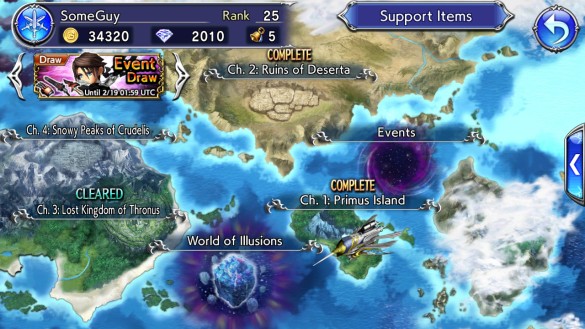
The Quest Menu doubles as the Overworld map in DFFOO. Areas are called “Chapters” and are initially locked. Unlock more Chapters by clearing previous ones
Each Chapter in Opera Omnia features its own unique map, and usually starts out with a single Story Quest. Progressing in the game is pretty straightforward. Just keep clearing Quests in a Chapter as they show up on the map until you get to the Final one. Part of the fun comes from mixing your teams up and finding the party that works for you. Use a single party to plough through the game, or take the time to level each warrior. Quests are re-playable without limits, so if anyone in the party seems to be behind the others, having them catch up is not a going to be a problem.
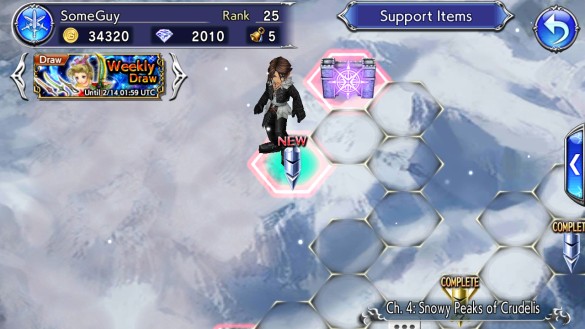
FFVIII’s Squall Leonheart standing next to a newly unlocked Battle Quest with a Gate Quest behind him in Chapter 4 of DFFOO. There are four types of Quests in a Chapter: Story Quests which play a cut-scene to progress the story, and sometimes recruit a new warrior; Treasure Quests which give up treasure outright; Gate Quests which block your path until you meet certain story or battle conditions, and; Battle Quests where monsters lurk, waiting to be defeated
FFX‘s CTB system and Dissidia‘s BRV system both return, but as a hybrid to power Opera Omnia‘s turn-based combat. But instead of merely being a re-hash of either, the two together makes for deep strategic gameplay where everything comes in to play. This is no more apparent than when playing Hard mode. In Hard mode, all Battle Quests are upgraded with more powerful monsters, and expensive rewards that you could only get either from later Chapters, or by waiting or paying for them. But we’re putting the cart before the horse here.
The tutorials are seamlessly integrated into the Quests in Chapter 1, so that gets players right in on the action without missing a beat. Plus they are pretty general in nature, still leaving room for a player’s creativity in dealing with the game’s challenges.
Battle Quests are all virtually the same. There are three one-time Missions to do: 1. Don’t get KO’d; 2. Clear the Battle within or using less than a set number of turns, and; 3. Either have a particular warrior in your party, or inflict a Break status a set number of times or more. There is also a Target Score to meet: after a Battle, you are also a scored based on various factors, like how much damage you dealt and received, how quickly you defeated a monster, etc. To complete a Battle Quest, all Mission conditions should be met and the Target Score met or exceeded. The game grants additional rewards for completing these on top of loot drops from defeated monsters.
Gameplay could get repetitive real quick because of this, but seasoned Final Fantasy vets wouldn’t mind, but rather feel right at home. For everyone else, fortunately, there’s Hard mode.
Hard mode imposes stiffer conditions to Battle Quests, like a higher Target Score and a relatively lower set of turns. But the biggest challenge comes in through Mission 3: in Hard mode, Mission 3 is invariably replaced with, “Don’t suffer Break status, at all.” This becomes a particular threat because enemy AI gives priority to inflicting Break rather than going for damage in most cases, and usually has two or more monsters targeting a single character to increase the chances of that happening. While this AI tactic might seem cheap at first glance, it really isn’t, as in most battles, the player’s party outmatches the AI’s three-to-two. While the early challenges are easily circumvented by persistently leveling up your warriors, this becomes less effective in time because the game caps characters at level 50.
To put it mildly, trying to consistently beat Hard mode Quests makes Opera Omnia a very addicting game indeed.
Upgrading characters involve getting them the necessary equipment. Weapons and armor can be drawn from shops using Gems. Yes. Drawn. One major drawback to this game is that equipment cannot be purchased directly, but are hidden behind a randomized raffle where you never know what you’re gonna get. This gets really frustrating in later Chapters when gems become even rarer and even more difficult to obtain, and you’ve already squandered the last of your gems on a crap three-star robe.
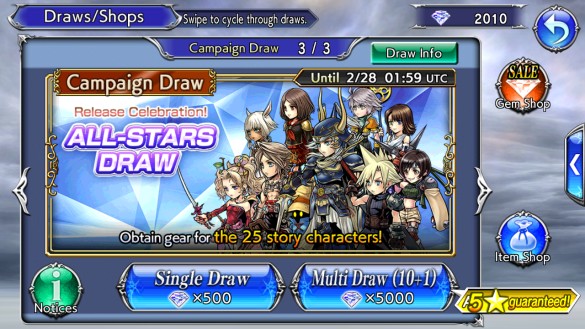
Equipment is randomly drawn from shops in DFFOO. Here, there is a choice to randomly draw a weapon or armor of undetermined rarity for 500 gems, or 11 weapons or armor, also of undetermined rarity, but at least one is guaranteed to be a gold standard piece of equipment with five-stars
On the upside, obtaining Gil used to upgrade equipment is not as big of a problem as they are steadily collected with every Battle Quest cleared, even in re-plays. However, obtaining materials, the other factor needed in upgrading equipment requires a bit of grinding as, just like gems, they aren’t obtained any other way than by clearing one-time Missions. This is where early access to the optional areas becomes handy, where these crafting materials are offered as rewards with any consistency though still a bit rare.
Fortunately, monsters often drop crappy two-star weapons and armor, and the game allows these to be used to upgrade other equipment. They don’t add much to the mix but could help pick up the slack when there aren’t enough crafting materials around. Also a definite plus.
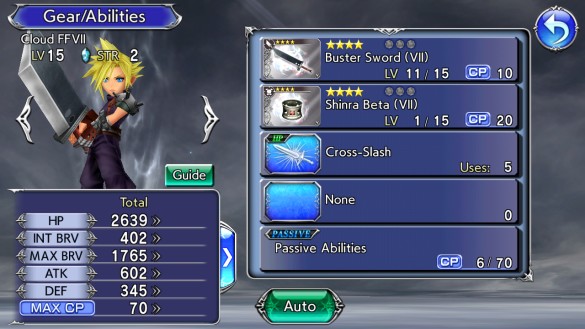
Cloud Strife from FFVII sporting four-star silver standard equipment. Equipping weapons and armor with an affinity to that character grants additional bonus in battle. Characters equipped with these get an aura around them
Players also get Daily bonuses just by logging in, with the rewards nearly at par with those to be won by grinding. Inevitably, however, the law of averages is going to catch up, and players will start to hit that paywall when grinding stops being as rewarding like it was the first few weeks. It’s still a free-to-play game and purchases really aren’t necessary so you still have the option to take the slow route. If things are moving a little too slow, there’s always Co-op Mode to pass the time.
There’s no functional chat in Co-Op mode, but players can communicate using “Stickers” which are essentially generic messages. A little crude, but it gets the job done, and they’re cute to boot.
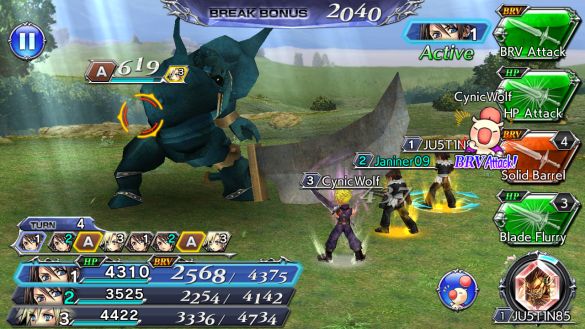
Co-op battles work like regular battles but players only have control over their own warriors. Shown here, Player 3 is asking Player 1 to use a BRV Attack through a sticker
THE VERDICT
Overall, Dissidia Final Fantasy Opera Omnia delivers on more than just nostalgia. With a solid repertoire of warriors, the creative use of of beloved game mechanics of old for a fresh take on turn-based battle, enough challenges to keep you occupied, and a Co-op mode to keep you distracted, it’s no wonder if this is the Dissidia game that will be remembered fondly in the future as the one that ushered in 2018 for Square Enix rather than its shinier, pricier cousin. At the very least, this game should tide you over until they eventually release Kingdom Hearts III later this year.

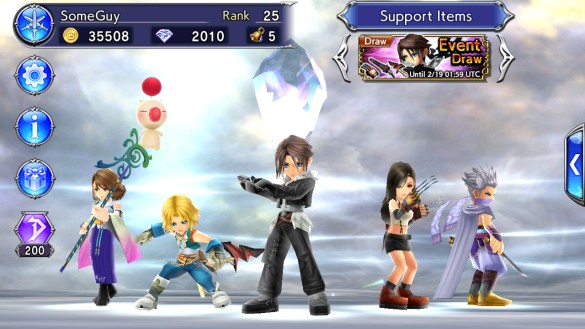
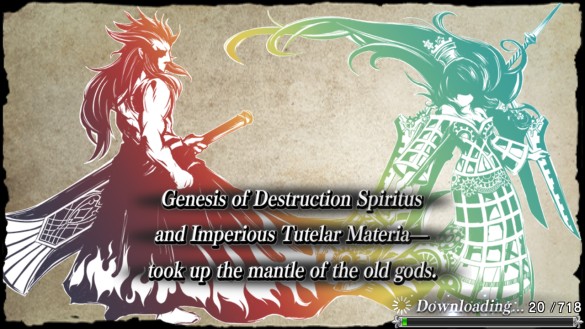
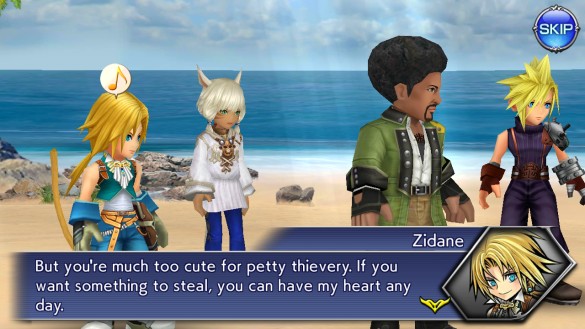

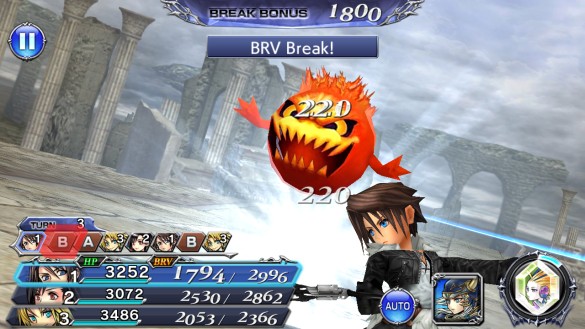
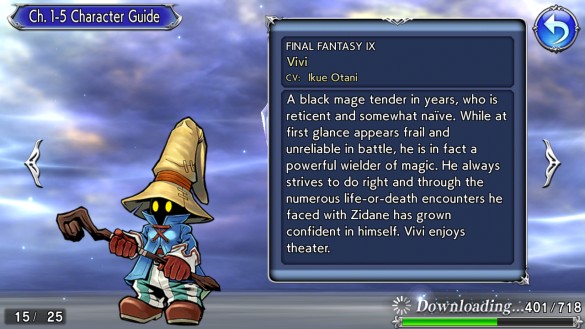
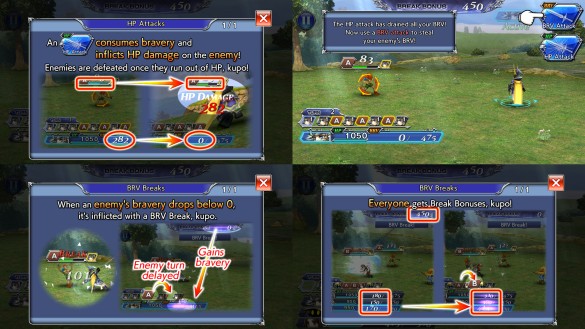
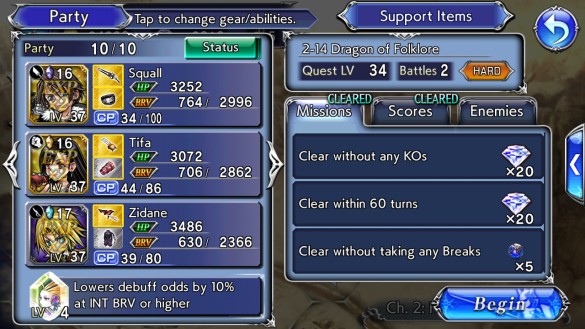
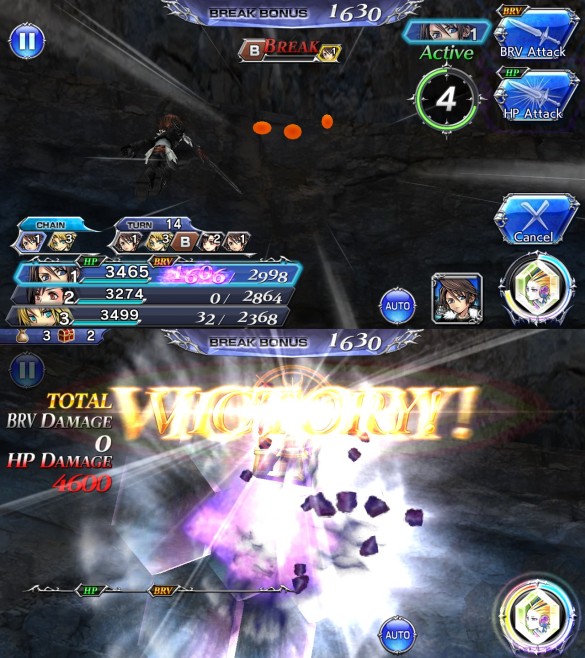
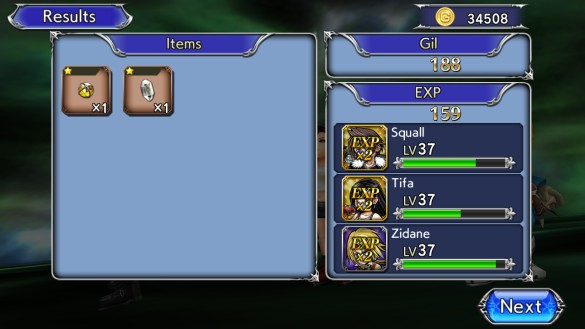
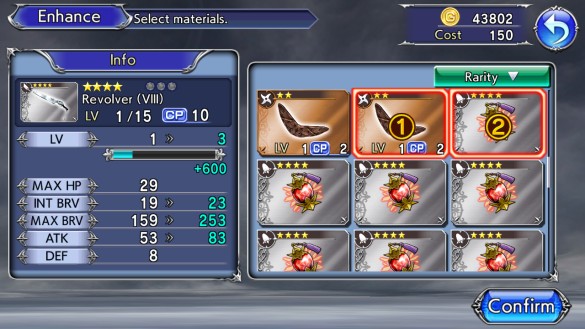
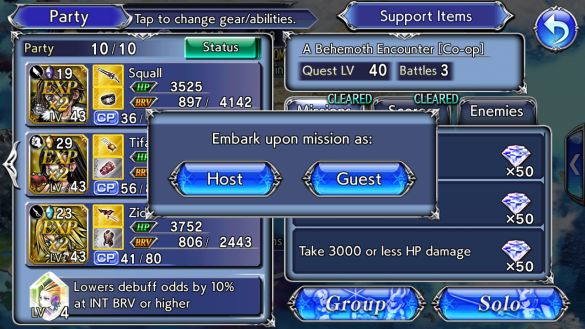
















UPDATE
Looks like the “World of Illusions” ended earlier today. It was subtitled “Carbuncle” and is/was one of the better places for grinding. Hoping they open a new World of Illusions quest soon.